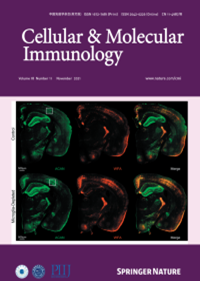Dermal adipogenesis protects against neutrophilic skin inflammation during psoriasis pathogenesis
IF 19.8
1区 医学
Q1 IMMUNOLOGY
引用次数: 0
Abstract
The immune response of the skin to danger signals involves rapid recruitment of neutrophils, but their excessive accumulation leads to inflammatory skin diseases, such as psoriasis; however, the mechanisms governing their initiation and resolution are poorly understood. Here, we revealed a dynamic immunoregulatory role of dermal white adipose tissue (dWAT) in the progression and resolution of neutrophilic skin inflammation in an imiquimod-induced psoriasis mouse model. During inflammation onset, dWAT repopulates PDGFRA+ preadipocytes (pAds), which secrete CXCL1 and SAA3, attracting and activating CXCR2+ neutrophils. These neutrophils further activate pAds through the IL-1R-NFκB-C/EBPδ pathway, establishing a self-sustaining inflammatory loop. Paradoxically, prolonged IL-1β signaling triggers PPARγ-dependent adipogenesis, transitioning pAds into anti-inflammatory early adipocytes that resolve neutrophilic inflammation via lipid mediators. Inhibition of adipogenesis, via pharmacological or genetic inhibition of PPARγ, disrupts the formation of early adipocytes, prevents neutrophil regression, and exacerbates inflammation. Analysis of human psoriatic cells revealed a C/EBPδ+ dermal fibroblast (dFB) subpopulation enriched with preadipocytes, the IL-1 pathway, and inflammatory gene signatures. Furthermore, transcriptomic analyses revealed a negative correlation between the neutrophil-related inflammatory response and the dermal lipogenesis response in generalized pustular psoriasis. Together, our findings reveal the dual role of dWAT: PDGFRA+ pAds initiate inflammation via CXCL1/IL-1β crosstalk with neutrophils, whereas PPARγ-driven adipogenesis resolves this process through lipid mediators. This work establishes dWAT as a critical immunomodulatory hub and proposes adipogenic reprogramming of proinflammatory fibroblasts or topical delivery of early adipocyte lipids as innovative therapies for neutrophil-driven skin diseases, such as psoriasis and ulcers. Our study uncovers a dynamic immunoregulatory role of dermal white adipose tissue (dWAT) in the progression and resolution of neutrophilic skin inflammation in an imiquimod-induced psoriatic mouse model. Initially, dWAT undergoes lipolysis and expands preadipocytes (pAds) secreting CXCL1/SAA3 to recruit neutrophils, which amplify inflammation via IL1β and activate pAds through the IL1-NFκB-C/EBPδ pathway. Prolonged IL1β exposure triggers PPARγ-dependent differentiation of pAds into early adipocytes, producing anti-inflammatory lipids that resolve neutrophilic inflammation. We also observed a negative correlation between neutrophil-related inflammatory response with dermal lipogenesis is also observed in human psoriasis. These findings highlight dWAT as an immunomodulatory hub, suggesting adipogenic reprogramming or lipid delivery as novel psoriasis therapies.

在牛皮癣发病过程中,真皮脂肪生成可防止中性粒细胞皮肤炎症。
皮肤对危险信号的免疫反应涉及中性粒细胞的快速募集,但它们的过度积累导致炎症性皮肤病,如牛皮癣;然而,控制其产生和解决的机制却知之甚少。在此,我们揭示了皮肤白色脂肪组织(dWAT)在吡喹莫德诱导的银屑病小鼠模型中中性粒细胞皮肤炎症的进展和消退中的动态免疫调节作用。在炎症发作期间,dWAT重新填充PDGFRA+前脂肪细胞(pad),其分泌CXCL1和SAA3,吸引和激活CXCR2+中性粒细胞。这些中性粒细胞通过IL-1R-NFκB-C/EBPδ途径进一步激活pad,建立一个自我维持的炎症循环。矛盾的是,延长的IL-1β信号会触发ppar γ依赖性脂肪形成,将pad转化为抗炎的早期脂肪细胞,通过脂质介质解决嗜中性粒细胞炎症。通过药物或基因抑制PPARγ来抑制脂肪形成,破坏早期脂肪细胞的形成,阻止中性粒细胞消退,并加剧炎症。对人银屑病细胞的分析显示,C/EBPδ+真皮成纤维细胞(dFB)亚群富含前脂肪细胞、IL-1通路和炎症基因特征。此外,转录组学分析显示,在广泛性脓疱性银屑病中,中性粒细胞相关炎症反应与皮肤脂肪生成反应呈负相关。总之,我们的研究结果揭示了dWAT的双重作用:PDGFRA+ pAds通过CXCL1/IL-1β与中性粒细胞的串导启动炎症,而ppar γ驱动的脂肪形成通过脂质介质解决这一过程。这项工作确立了dWAT作为一个关键的免疫调节中枢,并提出了促炎成纤维细胞的脂肪生成重编程或局部递送早期脂肪细胞脂质作为中性粒细胞驱动的皮肤病(如牛皮癣和溃疡)的创新疗法。
本文章由计算机程序翻译,如有差异,请以英文原文为准。
求助全文
约1分钟内获得全文
求助全文
来源期刊
CiteScore
31.20
自引率
1.20%
发文量
903
审稿时长
1 months
期刊介绍:
Cellular & Molecular Immunology, a monthly journal from the Chinese Society of Immunology and the University of Science and Technology of China, serves as a comprehensive platform covering both basic immunology research and clinical applications. The journal publishes a variety of article types, including Articles, Review Articles, Mini Reviews, and Short Communications, focusing on diverse aspects of cellular and molecular immunology.

 求助内容:
求助内容: 应助结果提醒方式:
应助结果提醒方式:


